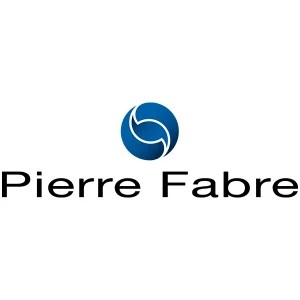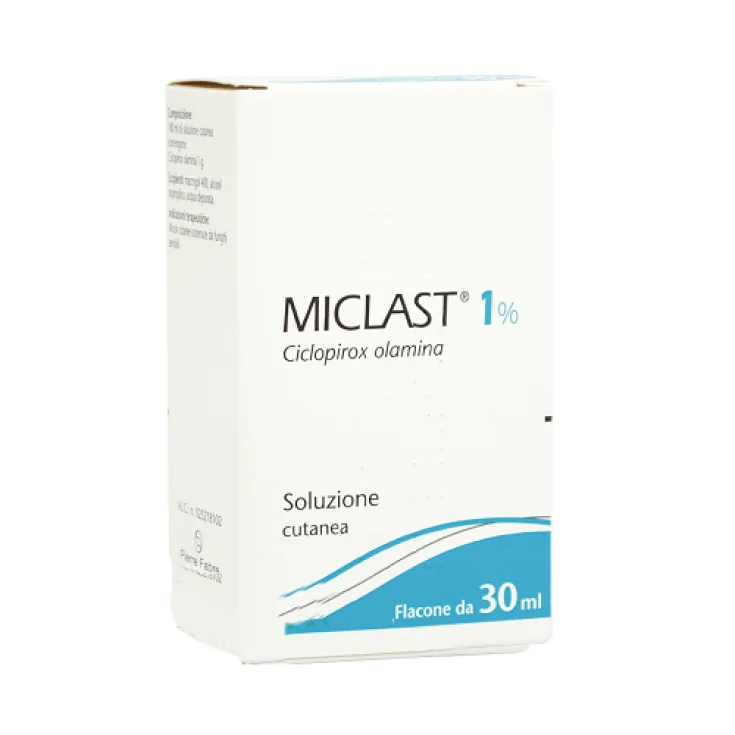Miclast 1% Cutaneous Solution 30ml

- Brand: PIERRE FABRE ITALIA SpA
- Product Code: 025218102
- EAN:
- Availability: In Stock (evaso in 24 ore)
- 3 items
for 10,56€ each - 4 items
for 10,35€ each - 5 items
for 10,13€ each
Miclast 1% Cutaneous Solution
Excipients contained in Miclast
Contraindications for Miclast Cutaneous Solution
Warnings and precautions for using Miclast
Undesirable effects with the use of Miclast
Miclast in Pregnancy and breastfeeding
Miclast what it is for
Miclast is a cutaneous solution useful in the case of cutaneous mycoses sustained by sensitive fungi.
Composition for Miclast :
Active ingredient: Cream: 100 g of cream contain: Ciclopirox olamine 1 g. Skin emulsion: 100 g of emulsion contain: Ciclopirox olamine 1 g. Skin powder: 100 g of powder contain: Ciclopirox olamine 1 g. Cutaneous solution: 100 ml of solution contain: Ciclopirox olamine 1 g.
Excipients contained in Miclast
Cream: Octyldodecanol, light liquid paraffin, stearyl alcohol, cetyl alcohol, myristyl alcohol, polysorbate 60, sorbitan stearate, benzyl alcohol, lactic acid, purified water. Skin emulsion: Polyoxyethylene glycol palmito-stearate, polyoxyethylene glycerides of saturated fatty acids, liquid paraffin, benzoic acid, butylhydroxyanisole, purified water. Skin powder: anhydrous colloidal silica, pregelatinised maize starch Skin solution: Macrogol 400, isopropyl alcohol, purified water.
Contraindications for Miclast Cutaneous Solution
Hypersensitivity to ciclopirox olamine or to any of the excipients. The powder should not be applied to open wounds.
How is Miclast used
The dosage includes various preparations which allow to adopt, in the opinion of the doctor, the one most suitable for the individual case. Unless otherwise prescribed, the dosage is usually the following: Cream: apply 2 or 3 times a day on skin lesions and let the preparation dry. Repeat the treatment until the skin lesions disappear (usually 2 weeks); to avoid relapses it is recommended to continue for another 1-2 weeks. The cream is particularly suitable for hairless and limited areas. Skin emulsion: shake the bottle well before use. Apply 2 or 3 times a day on skin lesions and let the preparation dry. Repeat the treatment until the skin lesions disappear (usually 2 weeks); to avoid relapses it is recommended to continue for another 1-2 weeks. The emulsion is indicated for extended skin areas and for mycosis of hairy areas. Skin powder: sprinkle the affected areas 1-2 times a day and repeat the treatment until the skin lesions disappear; to avoid relapses it is recommended to continue for another 1-2 weeks. It is recommended to use the powder for prophylactic purposes and for the disinfection of socks and shoes. Skin solution: apply 2-3 times a day, rubbing lightly and repeat the treatment until the skin lesions disappear (usually 2 weeks); to avoid relapses it is recommended to continue for another 1-2 weeks.
Warnings and precautions for using Miclast
The product must not come into contact with the eyes. Cyclopirox olamine should be used with caution and under direct medical supervision: - in case of concomitant systemic antifungal treatment; - in subjects with a history of immunosuppression; - in patients with compromised immune systems, such as transplant recipients and those with HIV infection; - in diabetic individuals. The use, especially if prolonged, of products for topical use, can cause sensitization phenomena. In this case, the treatment must be interrupted and suitable therapeutic measures adopted. During treatment, the hygiene measures recommended by the doctor must be strictly observed. Warnings relating to some excipients Cream: contains stearyl alcohol and cetyl alcohol, which can cause local skin reactions (eg contact dermatitis). Skin emulsion: contains benzoic acid and butylhydroxyanisole which can cause local skin reactions (eg contact dermatitis) or be mildly irritating to the skin, eyes and mucous membranes.
Interactions
They are not known.
Undesirable effects with the use of Miclast
Cream, Skin Emulsion and Skin Solution: Side effects observed during clinical trials are listed below by System Organ Class and by frequency. Frequencies are defined as: common (≥ 1/100 to <1/10), uncommon (≥ 1/1000 to <1/100), not known (cannot be estimated from the available data). Immune system disorders: Uncommon: hypersensitivity reactions, requiring discontinuation of treatment. General Disorders and Administration Site Conditions: Common: Transient exacerbation of local symptoms in the application area, such as burning sensation, erythema and itching, which do not require discontinuation of treatment. Uncommon: blisters in the application area, which need to stop treatment. Skin and subcutaneous tissue disorders: Frequency not known: reactions such as eczema and contact dermatitis have been reported during marketing. Although no systemic effect has been reported, this should be considered in patients undergoing prolonged treatment over large surfaces, broken skin, mucosa or under occlusive dressing. Dermal Dust: Undesirable effects observed during marketing are listed below by System Organ Class (frequency not known). General Disorders and Administration Site Conditions: Allergic reactions in the application area, corresponding to itching, irritation, erythema and itching, have been reported during use of Miclast powder. Skin and subcutaneous tissue disorders: Reactions such as eczema and contact dermatitis have been reported on very rare occasions.
Miclast in Pregnancy and breastfeeding
Like any other medical therapy, in pregnant women, during lactation and in very early childhood, the product should be used only in case of real need and under the direct supervision of the doctor.
Format
Miclast 1% is sold in packs of 30ml






